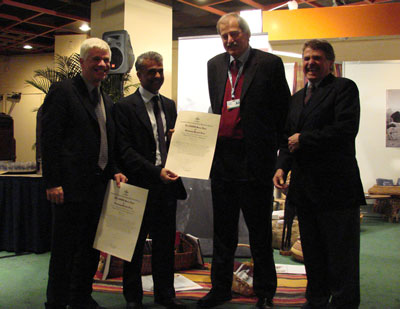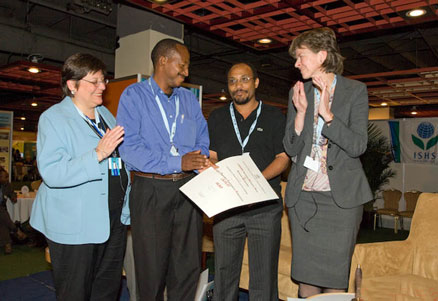Research centres are honoured for their work to preserve the diversity of the world’s key food and forage crops.
Twelve centres of the Consultative Group on International Agricultural Research (CGIAR) recently won the CGIAR’s Outstanding Partnership Award for their management of genebanks and effective stewardship of plant genetic resources they hold in trust for the world community.
The Partnership’s genebanks are vital for achieving food security and protecting plant genetic diversity and represent the most important international effort to safeguard the world’s agricultural legacy. ILRI and the other 11 centres of the CGIAR hold more than 600,000 samples of crop-plant diversity. These include wild relatives and more than half of the global total of farmer-created varieties, which are a rich source of sought-after characteristics.
Base genebanks are used for long-term security storage of original germplasm collections. They act as a repository of materials that have been reasonably characterized and which may or may not have current interest or use by plant breeders. Collected materials are preserved until such time as there are enough resources available for them to be characterized and evaluated. Active genebanks are used for current research and distribution of seeds, with all seeds in active collections freely available in small quantities to all research workers and distributed both directly and through networks.
Jean Hanson, a plant geneticist working at the Addis Ababa campus of the International Livestock Research Institute (ILRI), said, ‘This Outstanding Partnership Award recognizes almost 20 years of collaboration between staff of the CGIAR genebanks, first as an ad hoc working group and community of practice and later as the formal steering committee for the CGIAR System-wide Genetic Resources Programme.
‘Partnerships involving staff of 12 CGIAR centres are rare. This award recognizes an active and collegial partnership that has stood the test of time and changes in staffing and funding within the CGIAR genebank community.’
This Outstanding Partnership Award, announced at the CGIAR’s Annual General Meeting in Washington, DC, in December 2006, recognizes the teamwork that provided stewardship of global public goods central to the CGIAR’s work and also provided leadership to the whole plant genetic resources community. While discharging its duties as custodians of the CGIAR in-trust collections, the Partnership has advanced research in the many scientific disciplines providing leadership for germplasm conservation and use, raised awareness world-wide of the importance of genetic resources to development, and represented the CGIAR in important international fora, from the Earth Summit, held in Rio in 1992, to the first meeting of the Governing Body the International Treaty for Plant Genetic Resources for Food and Agriculture, in 2006.
Collective action by the Partnership generated common policies and practices with which to administer the CGIAR collections under legal agreements governing their in-trust status. Employing these common policies and practices has ensured the highest standards in germplasm conservation and dissemination of that germplasm and related information. Achieving these two objectives demanded combining conservation and information science with smart legal and policy know-how, skillful negotiation and tactful diplomacy.
To secure the in-trust collections, the Partnership took an open, self-critical approach to meet the highest international standards. The Centres continue their work to take conservation technology forward by convening meetings to explore methodologies; publishing guidelines on field and in vitro genebank management and regeneration and other topics; scoping new areas for action, such as research on underutilized species and holistic approaches to agricultural biodiversity; and tackling research bottlenecks such as difficulties in storing clonal material. The Partnership has also conducted upstream research, examining the application of molecular genetics to genebanking, which led to wider developments such as the CGIAR initiation of a Generation Challenge Program.
Pulling technical, economic, policy and information components together, this Partnership helped materialize a vision of a co-ordinated global system for the conservation and use of plant genetic resources. This Partnership is providing coherent leadership of a global genetic resources system underpinning food security for humanity into the future.
Last October, world leaders in agricultural research signed agreements to guarantee long-term access to some of the world’s most important collections of agricultural biodiversity by placing all their ex-situ genebank collections under the International Treaty on Plant Genetic Resources for Food and Agriculture. The agreements require commercial users to share benefits with the global community. Eleven centres belonging to the Consultative Group on International Agricultural Research (CGIAR) were party to the agreements, which will allow breeders and other researchers to tap the collections for solutions to some of the world’s most pressing development problems, including drought, desertification and food and nutritional security. ‘World’s Most Diverse Forage Collection Comes under New Treaty’. (https://newsarchive.ilri.org/archives/452)ILRI maintains both an active and base genebank at its principal campus in Addis Ababa, Ethiopia. As part of its commitment to maintaining the collection as a global public good, ILRI claims no ownership nor seeks any intellectual property rights over the germplasm and related information. ILRI conserves its diverse forage collection to make it and relevant information freely available to scientists and the national agricultural research systems of developing and other countries.
CGIAR Genebank Community
The genebanks of the CGIAR Centres
01 International Center for Tropical Agriculture (CIAT), Colombia (represented by Daniel Debouck)
02 International Potato Center (CIP), Peru (represented by Willy Roca)
03 International Maize and Wheat Improvement Center (CIMMYT), Mexico (represented by Thomas Payne)
04 International Center for Research in the Dry Areas (ICARDA), Syria (represented by Jan Valkoun)
05 World Agroforestry Centre (ICRAF), Kenya (represented by Tony Simons)
06 International Centre for Research in the Semi-Arid Tropics (ICRISAT), India (represented by CLL Gowda)
07 International Institute for Tropical Agriculture (IITA), Nigeria (represented by Dominique Dumet)
08 International Livestock Research Institute (ILRI), Kenya (represented by Jean Hanson)
09 Bioversity International, Italy (represented by Laura Snook)
10 International Rice Research Institute (IRRI), Philippines (represented by Ruaraidh Sackville Hamilton)
11 West African Rice Development Association (WARDA), Benin (represented by Ines Sanchez)
Related organizations
12 United Nations Food and Agriculture Organization (FAO), Italy (represented by Linda Collette)
13 International Food Policy Research Institute (IFPRI), Washington, DC (represented by Melinda Smale)
14 CGIAR Systemwide Genetic Resources Programme (SGRP) Secretariat, Italy, (represented by Jane Toll)



